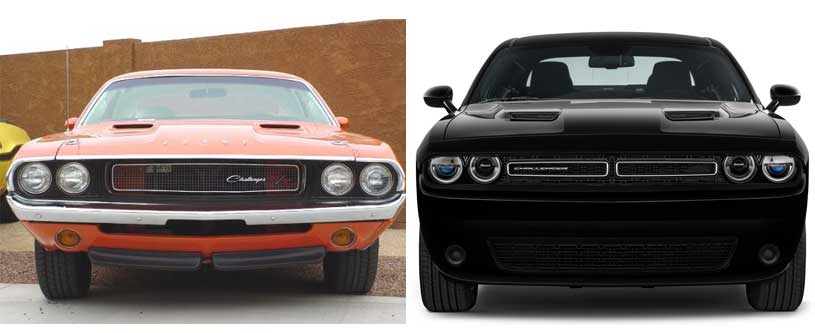Dodge Challenger – 2015-Present
2012-14
2008-11
1978-84
1972-74
1971
1970
Dodge Challenger History
First Generation
When Dodge Challenger burst on the car scene in 1970 it was supposed to be Dodge’s answer to Ford’s Mustang. Unfortunately, it was six years late to the pony show, and with premium features it ended up taking on Mercury Cougar and Pontiac Firebird while its cousin, Plymouth Barracuda, went up against the Mustang and Chevrolet Camaro.
Dodge tried hard to make the Challenger relevant by combining performance with customization options. Nine different engine choices were available along with body-paint colours like Plum Crazy and HEMI Orange. Owners could customize their Challengers with “bumblebee” stripes, twin-scooped hoods, “shaker” hoods, and rear deck wings.
After one year on the market the Challenger received minor styling enhancements that included two distinct tail lamps instead of a single one in the rear. The rectangle inside the grille was also divided into two narrower pieces and painted a different colour. The Challenger was refreshed several times throughout its first generation, mainly receiving different grille and lighting treatments while maintaining overall shape and size. Despite the effort Dodge decided to cease production after only four years.
Second Generation
Dodge Challenger returned in 1978 as a rebadged Mitsubishi Galant Lambda with a design that was already two years old. As a result, the second-gen Challenger did not retain any styling or design cues from the previous model. And despite being sportier than the MItsubishi model it did not live up to its Pony car status. Dodge’s decision to rebadge the pony car may have ruined what the Challenger nameplate represented at the beginning of the decade. Eventually, the design evolved into Chrysler’s K-platform, better known as the ever-popular K-cars. These were family sedans that lacked any racing DNA. In 1984 the Challenger nameplate was retired once again; and this time for more than 20 years.
Third Generation
The revival of the Dodge Challenger began in 2006 when a concept was unveiled at the North American International Auto Show in Detroit. The production model debuted in 2008. Retro styling reminiscent of the first Challenger made the third generation pony car an instant success. Double headlights and a rectangular grille indented into the hood made it look almost identical to the 70s model. Even the lower grille and round fog lights were in the same location, except the 70s Challenger had turn signals instead of fog lights. Despite being inevitably longer and taller the 2008 model was like a modern-day replica of Dodge’s first pony car.
Designers did a remarkable job making the 2008 coupe look like the first one. The side profile can’t be mistaken for anything but a Dodge Challenger. The long hood, the shape of the rear window, and the thick C-pillar that connects to the rotund rear end are practically the same. Even the single, trunk-wide red tail light with a white centre screams 1970 pony car. The retro-inspired Challenger remained unchanged until 2012 when the lower grille was flipped upside down to give it a ‘sad’ look. That tweak was the only exterior change the Challenger received since its rebirth.
Mark the 2015 Challenger down as having the most clever refresh in Dodge’s history. That statement may be far-fetched but what the designers did was simply brilliant. While the 2008 model shared design cues with the very first Challenger, the 2015 refresh was inspired by the refreshed, 1971 pony car. Exterior updates include two distinct tail lights and a split grille just like the ’71 Challenger had. The lower grille was inverted back into a ‘smile’ but retained its aggressive stance. These subtle changes continue to draw on Dodge’s heritage while evolving the design with modern features.
It will be interesting to see if Dodge will continue to borrow design elements from the first generation models. If so, the next Challenger should have front and rear fascia that resemble the 1972-74 models. Whatever the next design will be the evolution of the Challenger looks promising, as long as Dodge doesn’t make it look like the rebadged, second generation coupe.

